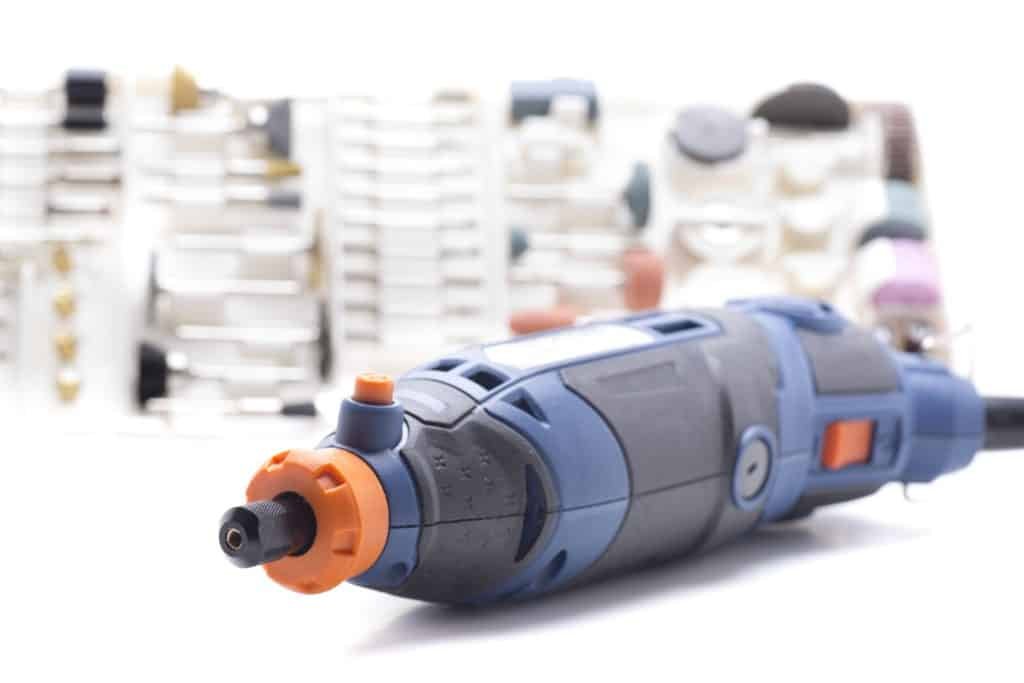Between 3D printing and at-home model-making, there are plenty of reasons you might need to sand plastic.
Unfortunately, plastic can be sharp when left with a rough edge, but it’s also pretty easy to scratch due to its composition. So, can you use a Dremel to sand plastic?
It’s possible to use a Dremel to sand plastic, provided you work with a 400 grit sanding disk. The more coarse the grit, the more likely it is you’ll damage your item.
Also, remember to use the Dremel at the lowest speed and take extra precautions to avoid snagging or scratching the plastic.
The rest of this article explains if you can use a Dremel to sand plastic, how to do it, and which Dremel bit is best for plastic.
So if you have a plastic piece that needs sanding or polishing, and you’re committed to using a Dremel for the job, keep reading!

How To Sand Plastic With a Dremel
As mentioned, you can sand plastic with a Dremel if you’re very careful and use the slowest speed setting.
You’ll want to work with a high-grit bit to keep from damaging your work. If you choose something lower, like 240-grit, you’ll probably see uneven surfaces and maybe sections in which the plastic is cut away.
Check out this video to see how lower grit bits affect plastic:
As you can see, the result was not smooth. Instead, it looked very rough and would still need polishing.
If you’re still unsure of the differences in grit, check out this video. You’ll see how each different number works, with the lower end leaving the surface very rough:
Once you understand the different types of sandpaper and grit, you’ll see why you should go for 400 or above when working with plastic.
Here are a few other factors to keep in mind for properly sanding plastic with a Dremel:
- Dremel sanding disks are best used with the tool facing towards the plastic piece you’re sanding or polishing.
- Always try to use the center of the disk for the best results.
- The recommended speed for use on plastic is 10-20000.
- Use a little bit of water to keep the plastic lubricated.
- Take lots of breaks as the tool will heat up as you work, leading to melted or further damaged surface.
- Finalize your finish with a microfiber polishing cloth loaded with polishing compounds.
Recommend Tools for Sanding Plastic With a Dremel
The first thing you’ll need is this 50pcs Abrasive Buffing Polishing Wheel Set from Amazon.com. You get 50 pieces, which means you’ll have plenty of extra wheels if you need to do more sanding.
This is 400 grit and is designed for polishing and buffing, meaning it should be gentle enough to sand plastic without damaging it.
Next, I like this NOVUS 7100 Plastic Polish Kit from Amazon.com.
This kit cleans, polishes, and restores plastic shields, and it comes with three different solutions, one for cleaning and shining, one for light scratches, and one for heavy scratches.
Finally, this Amazon Basics Fabric Cleaning Cloth from Amazon.com is made for use on glass, so it is extra gentle, which is essential for plastic after it has been polished or smoothed.
Additionally, it has a dual texture design, one for attracting dirt and the other for polishing and wiping.
The Best Way To Sand Plastic
As mentioned, it’s possible to use a Dremel to sand plastic, but it’s not the best method in the long run.
Instead of using a Dremel, the best way to sand plastic is to use sandpaper, beginning with wet 220-grit sandpaper and continuously making passes with finer papers until you’re happy with the result (source: Hunker: Tips on Sanding Plastic).
If you’re using the sandpaper method, the type of paper you’ll need is silicon carbide.
First, you should soak the paper in water for ten minutes and then sand the plastic in a circular motion. Otherwise, you’ll end up with deep scratches in the plastic.
Before sanding, you should clean the plastic with a detergent solution. You can home make your own detergent by mixing equal parts of vinegar and water.
Once you’re done sanding, use a polishing compound on the surface and buff it using a lambswool buffer.
For a buffing pad, I use the Porter-Cable Polishing Pad from Amazon.com because it is gentle on plastic, so it polishes without damaging the surface. Additionally, it fits a variety of orbit sanders.
Conclusion
I hope you found this article informative and that you feel more prepared to use your Dremel tool to work with plastic. As long as you follow this guidance, you should be good to go!





